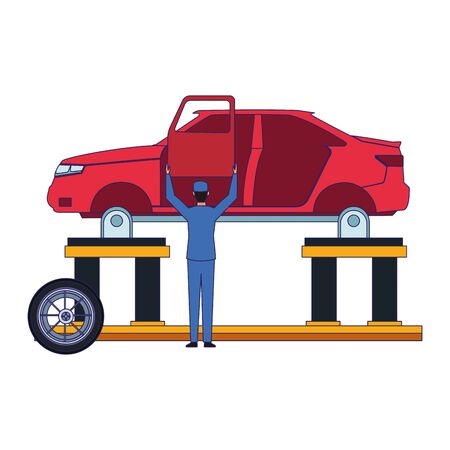Introduction to Vehicle Ownership Transfer in the UK
Transferring vehicle ownership in the United Kingdom is a crucial legal process that ensures the correct individual is recognised as the new keeper of a vehicle. This not only protects both buyer and seller from future liabilities but also guarantees that all records with the Driver and Vehicle Licensing Agency (DVLA) remain accurate and up to date. Whether you are selling your car privately, gifting it to a family member, or buying a used vehicle, understanding the steps involved is essential for compliance with UK law. An improper transfer can result in fines, penalties, or even legal disputes regarding unpaid tax or motoring offences. The table below provides an overview of why legally transferring vehicle ownership matters:
| Reason | Importance |
|---|---|
| Legal Compliance | Avoids fines and ensures all documentation is valid |
| Financial Responsibility | Clarifies who is responsible for tax, insurance, and penalties |
| Accurate DVLA Records | Keeps government records current and reduces risk of fraud |
In this article, we will guide you through the legal steps and share best practices for a smooth and compliant transfer of vehicle ownership in the UK.
2. Preparing for the Transfer
Before you begin the process of transferring vehicle ownership in the UK, it is crucial to gather all necessary documents and ensure everything is in order to avoid delays or legal complications. The following checklist outlines the essential paperwork and checks required:
| Document/Check | Description |
|---|---|
| V5C Logbook (Vehicle Registration Certificate) | This official document proves who is responsible for registering and taxing the vehicle. Both the seller and buyer must complete the relevant sections during the transfer. |
| Proof of Identity | Both parties should provide valid identification, such as a UK photocard driving licence or passport, to confirm their identity and address. |
| MOT Certificate (if applicable) | If the vehicle is over three years old, a valid MOT certificate should be presented to show it meets road safety and environmental standards. |
| Service History and Receipts | Optional but recommended, these documents reassure the buyer about the vehicle’s maintenance record. |
| Outstanding Finance Check | Sellers should confirm there is no outstanding finance on the car. Buyers are advised to check this independently as well. |
Essential Pre-Transfer Checks
- Verify that the details on the V5C logbook match both the vehicle and current owner’s information.
- Ensure there are no errors or discrepancies in documentation which could delay DVLA processing.
- If selling privately, arrange a safe location for exchanging documents and keys, such as at home or a bank branch.
Best Practice Tips
- Sellers should retain a copy or photo of completed documents for their records until confirmation from DVLA arrives.
- Never hand over keys or allow test drives without verifying genuine interest and proper insurance cover from potential buyers.
By preparing these documents and performing essential checks ahead of time, both buyers and sellers can ensure a smooth, compliant transfer process under UK law.

3. Completing the Legal Transfer
Transferring vehicle ownership in the UK requires strict adherence to legal procedures set by the Driver and Vehicle Licensing Agency (DVLA). Ensuring every step is completed correctly protects both seller and buyer from potential liabilities and future disputes. Here’s a step-by-step guide on how to complete the DVLA notification, along with an overview of responsibilities for each party.
Step-by-Step Guide to Notifying the DVLA
Online Transfer Process
- Visit the official DVLA website at gov.uk/sold-bought-vehicle.
- Both seller and buyer must have the vehicle log book (V5C) on hand.
- The seller enters the 11-digit reference number from the latest V5C document.
- Input all required details including buyer’s name and address.
- The DVLA updates its records instantly; both parties will receive confirmation emails.
Postal Transfer Process
- Complete Section 2 (new keeper details) of the V5C log book.
- Seller sends the completed V5C/2 “new keeper slip” to the buyer as proof of temporary ownership.
- The remaining part of the V5C is posted to: DVLA, Swansea, SA99 1BA.
- The DVLA will issue a new V5C to the buyer within approximately five working days.
Seller and Buyer Responsibilities at a Glance
| Responsibility | Seller | Buyer |
|---|---|---|
| Notify DVLA of transfer | ✔️ Required | |
| Keep proof of sale (receipt) | ✔️ Recommended | ✔️ Recommended |
| Receive new V5C document | ✔️ Will be sent by DVLA | |
| SORN (if vehicle off-road) | If applicable before transfer | If applicable after transfer |
| Insurance update/arrangement | ✔️ Cancel or amend policy | ✔️ Arrange new cover before driving away |
| Vehicle tax responsibility | No longer responsible post-transfer | ✔️ Must tax before using vehicle on public roads |
Important Reminders for Both Parties
- The seller should never leave the log book blank or give it entirely to the buyer; always complete your relevant sections and send them promptly to DVLA.
- The buyer should ensure receipt of the “new keeper slip” (V5C/2) as temporary proof until their own log book arrives.
- If you’re buying or selling privately, both parties are advised to keep written proof of sale—such as a signed receipt outlining date, price, vehicle details, and both parties’ names and addresses—for peace of mind and legal protection.
- If there are outstanding finance agreements on the car, these must be settled before transfer.
This careful approach ensures compliance with UK law, protects personal interests, and helps avoid unexpected fines or complications down the road.
4. Financial Implications and Insurance Considerations
Transferring vehicle ownership in the UK involves more than just paperwork; there are significant financial implications and insurance requirements to consider. Below, we provide practical advice on managing vehicle tax, addressing outstanding finance, and ensuring proper car insurance is in place throughout the transfer process.
Vehicle Tax Responsibilities
Unlike some countries where vehicle tax can be transferred, in the UK, vehicle tax (commonly referred to as road tax or VED) does not pass from seller to buyer. When you sell your vehicle, you must inform the DVLA immediately. This triggers an automatic refund for any full remaining months of tax. The new owner is responsible for taxing the vehicle before driving it away.
| Action | Who is Responsible? | When? |
|---|---|---|
| Cancel existing vehicle tax | Seller | On completion of sale |
| Tax the vehicle anew | Buyer | Before driving away |
Outstanding Finance Checks
If the vehicle has outstanding finance (such as a PCP or HP agreement), ownership cannot legally be transferred until the debt is settled. Buyers should always check if there is any existing finance by obtaining a vehicle history report. If you’re selling, ensure all financial obligations are cleared beforehand to avoid legal complications.
Steps to Resolve Outstanding Finance
- Contact your finance provider for a settlement figure.
- Pay off the remaining balance.
- Obtain confirmation that finance has been cleared before completing the sale.
Insurance During Transfer
Both parties should pay close attention to insurance coverage during the ownership transfer:
- The seller should notify their insurer of the sale immediately to cancel or amend their policy and avoid paying for cover they no longer need.
- The buyer must arrange suitable car insurance before taking possession of the vehicle. Driving without insurance is illegal and carries severe penalties in the UK.
Key Insurance Considerations Table
| Task | Responsible Party | Timing |
|---|---|---|
| Cancel/update existing insurance policy | Seller | Straight after sale completion |
| Obtain new insurance policy or add vehicle to existing policy | Buyer | Before driving away with the car |
Treating these financial and insurance steps with care not only protects both parties but also ensures compliance with UK law. Always keep documentary evidence of completed tasks for your records and peace of mind.
5. Best Practices and Common Pitfalls
Tips for a Smooth Transaction
Ensuring a seamless transfer of vehicle ownership in the UK requires careful attention to detail. Whether you are buying or selling, following these best practices will help you avoid unnecessary delays and legal complications.
- Double-check Documents: Ensure all paperwork, including the V5C logbook and MOT certificates, is accurate and up-to-date.
- Confirm Payment Method: Agree on a secure payment method, such as bank transfer, to minimise the risk of fraud.
- Complete the V5C Section: Fill out the relevant sections of the V5C logbook together with the other party to prevent errors.
- Notify DVLA Promptly: Inform DVLA immediately of the change in ownership—this is crucial for both buyer and seller protection.
- Get Written Receipts: Both parties should sign and keep a copy of a receipt outlining the transaction details.
Common Mistakes to Avoid
| Mistake | Description | Consequence |
|---|---|---|
| Incomplete V5C Logbook | Failing to fill out all required fields or using incorrect information | Delays in registration; potential fines from DVLA |
| No Proof of Sale/Purchase | Lack of written agreement or receipt | Difficulties proving ownership or resolving disputes |
| Delayed DVLA Notification | Not informing DVLA immediately after sale or purchase | The seller may remain liable for fines or penalties incurred by the new owner |
| Unverified Vehicle History | Not checking MOT status, outstanding finance, or accident history | Unexpected costs or legal issues for the buyer |
| Ineffective Payment Methods | Using cash without receipts or insecure online transfers | Increased risk of fraud or non-payment |
Recommendations for Buyers and Sellers
For Buyers:
- Verify Vehicle Details: Use services like HPI Check to confirm there is no outstanding finance or recorded theft.
- Inspect the Vehicle: Arrange a thorough inspection and test drive before finalising payment.
- Secure Insurance: Arrange car insurance before driving your new vehicle away—its illegal to drive uninsured in the UK.
For Sellers:
- Remove Personal Items: Double-check that all personal belongings are removed from the car before handing it over.
- Surrender Number Plates (if required): If transferring a personalised plate, ensure the correct process is followed via DVLA.
- No Partial Transfers: Never leave any section of the V5C incomplete; always complete and submit your part to DVLA.
- Avoid Handing Over Keys Prematurely: Only hand over keys once payment has cleared and paperwork is done.
Taking these proactive steps can help both buyers and sellers avoid common pitfalls, making the vehicle ownership transfer process smooth, secure, and compliant with UK regulations.
6. Final Checklist and Next Steps
Summary Checklist for Verifying a Successful Transfer
Ensuring the successful transfer of vehicle ownership in the UK involves attention to detail and proper documentation. Both the seller and buyer have key responsibilities to protect their interests. Use this checklist to verify that all essential steps have been completed:
| Step | Sellers Responsibility | Buyers Responsibility |
|---|---|---|
| V5C Logbook Update | Notify DVLA online or by post; provide buyer with green new keeper slip (V5C/2) | Receive V5C/2; expect new V5C from DVLA within 4 weeks |
| Proof of Sale | Provide a dated receipt with vehicle details, mileage, sale price, and both parties signatures | Retain receipt as proof of purchase |
| MOT Certificate | Hand over valid MOT certificate if applicable | Check MOT status online for validity |
| Insurance | Cancel existing insurance or transfer to another vehicle | Arrange appropriate insurance before driving away |
| Road Tax (Vehicle Excise Duty) | Inform DVLA for any refund due on remaining tax months | Tax the vehicle immediately before use on public roads |
| Personal Belongings & Number Plates | Remove all personal items and private plates if not sold with the car | If buying with a private plate, confirm transfer process is complete |
Next Steps After Completion: Guidance for Both Parties
For Sellers:
- Deregister Vehicle: Confirm you’ve notified the DVLA—failure may leave you liable for penalties or fines related to the new owner’s actions.
- Insurance Cancellation: Contact your insurer promptly to cancel or amend your policy.
- Direct Debit: If road tax was paid via Direct Debit, ensure it is cancelled with the DVLA after sale confirmation.
- Record Keeping: Keep a copy of the sales receipt and any correspondence for your records for at least 12 months.
- SORN (Statutory Off Road Notification): If not selling but taking the car off the road, notify DVLA for SORN status.
For Buyers:
- Check New Keeper’s Details: Ensure you receive your updated V5C logbook from the DVLA within four weeks; contact them if it does not arrive.
- MOT & Service History: Review the MOT certificate and service history for peace of mind regarding vehicle condition.
- Arrange Insurance: Have valid insurance in place before driving; driving uninsured is illegal in the UK.
- Tax Your Vehicle: Tax must be purchased immediately upon ownership change—even if there is still time left on previous tax (tax does not transfer).
- Email Confirmation: If you used the DVLA online service, keep email confirmation as proof until you receive your documents.
- PENALTIES: Be aware that failure to follow these steps can result in fines, points on your licence, or seizure of your vehicle.
Your Financial Peace of Mind Matters!
The legal and financial implications of transferring a vehicle are significant. By following this final checklist and being proactive about next steps, both buyers and sellers can avoid unnecessary risks, fines, or disputes—ensuring a smooth transition and protecting your interests throughout the process.


